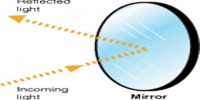Nicol prism was designed by William Nicol. One of the most common forms of the Nicol prism is made by taking a calcite crystal whose length is three times its breadth. It is cut into two halves along the diagonal so that their face angles are 720 and 1080. And the two halves are joined together by a layer of Canada balsam, a transparent cement as shown in Figure. For sodium light, the refractive index for ordinary light is 1.658 and for extra−ordinary light is 1.486. The refractive index for Canada balsam is 1.550 for both rays, hence Canada balsam does not polarize light.
A monochromatic beam of unpolarized light is incident on the face of the Nicol prism. It splits up into two rays as ordinary ray (O) and the extraordinary ray (E) inside the Nicol prism (i.e) double refraction takes place. The ordinary ray is totally internally reflected at the layer of Canada balsam and is prevented from emerging from the other face.
The extraordinary ray alone is transmitted through the crystal which is plane polarized. The Nicol prism serves as a polarizer and also an analyzer.

Fig: Nicol prism












